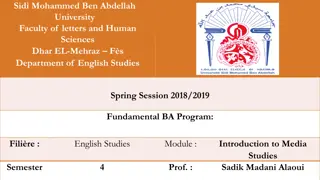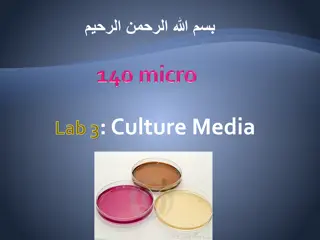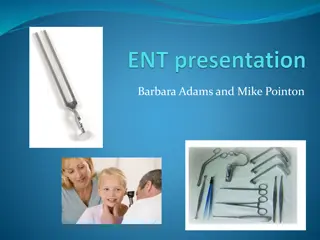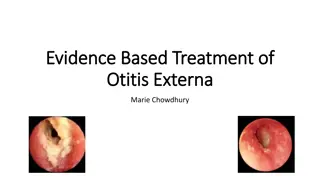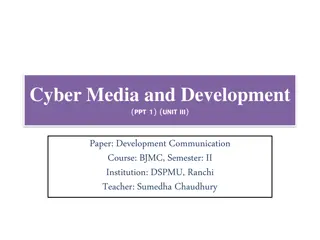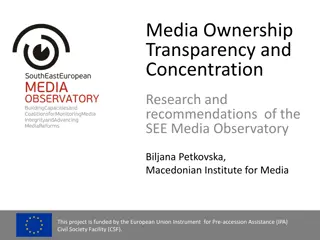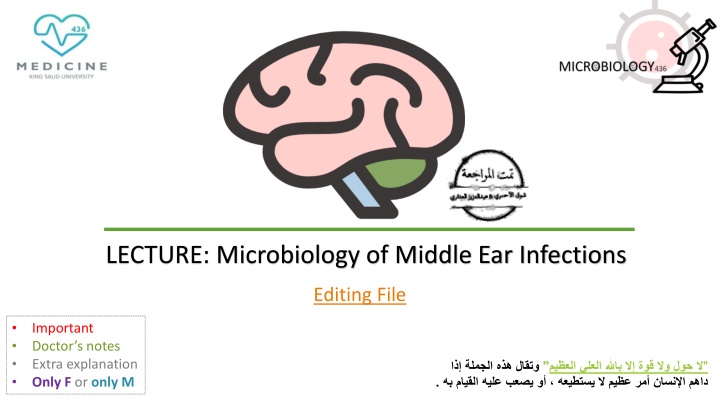
Microbiology of Middle Ear Infections: Insights & Management
Explore the microbiology of middle ear infections including definitions, classifications, epidemiology, pathogenesis, risk factors, clinical features, diagnosis, and management. Learn about common complications and gain insights for a comprehensive understanding.
Download Presentation

Please find below an Image/Link to download the presentation.
The content on the website is provided AS IS for your information and personal use only. It may not be sold, licensed, or shared on other websites without obtaining consent from the author. If you encounter any issues during the download, it is possible that the publisher has removed the file from their server.
You are allowed to download the files provided on this website for personal or commercial use, subject to the condition that they are used lawfully. All files are the property of their respective owners.
The content on the website is provided AS IS for your information and personal use only. It may not be sold, licensed, or shared on other websites without obtaining consent from the author.
E N D
Presentation Transcript
LECTURE: Microbiology of Middle Ear Infections Editing File Important Doctor s notes Extra explanation Only F or only M " " .
OBJECTIVES: Upon completion of the lecture , students should be able to: Define middle ear infection Know the classification of otitis media (OM). Know the epidemiology of OM Know the pathogenesis & risk factors of OM. List the clinical features of OM. Know the diagnostic approaches of OM. Know the management of OM. Recall common complications of OM.
Definitions: Definitions: o Middle ear is the area between the tympanic membrane and the inner ear including the Eustachian tube. o Otitis media (OM): is inflammation of the middle ear. Anatomy of the Middle Ear: Anatomy of the Middle Ear: OM OM- -Classification: Classification: o Acute OM o Chronic OM o Secretory ( Serous) OM
OM OM - - Epidemiology Epidemiology o Most common in infants 6 to 18 months of age (2/3 of cases)* . Improves with age, why ? o The Eustachian Tube which vents the middle ear to the nasopharynx is horizontal in infants, difficult to drain naturally, its surface is cartilage ,and the lymphatic tissue lining is an extension of adenoidal tissue from the back of the nose.** o Often preceded by viral upper respiratory infection (URTI). o Accompanied by viral upper respiratory infection (URTI). Extra picture *The baby is protected on his first 6 months because of the IgG he got from his mother **connected to the back of the nose including tonsils
OM OM- -Pathogenesis and Risk Factors: Pathogenesis and Risk Factors: How the otitis media is developed ? o URTI or allergic condition cause edema or inflammation of the tube. o In normal situation the Functions of the tube *eustachain tube* ( ventilation, protection and clearance ) when they are disturbed they may lead to OM. o During this process the Oxygen lost leading to negative pressure o Pathogens enter from nasopharynx into the middle ear. o Colonization and infection result. OM OM- - Other risk factors Other risk factors o Anatomic abnormalities o Medical conditions such as Cleft palate ,obstruction due to adenoid or nasogastric tube* or malignancy, immune dysfunction. http://t1.gstatic.com/images?q=tbn:J3ptxBEM_0ul-M:http://www.biomedcentral.com/content/figures/1471-2350-5-15-1.jpg o Exposure to pathogens from day care. o Exposure to smoking. Some studies relieve that the smoker mothers or fathers they may cause OM to their child, the smoking may initiate allergic and inflammatory prosseces *nasogastric tube: a tube passed into the stomach via the nose for nutritional support or aspiration of stomach contents
EXTRA SLIDE - FOR THE NEXT SLIDE Garm +ve Gram -ve Streptococcus pneumonia : Cocci in chains Alpha hemolytic Catalase -ve Haemophilus influenzae : Cocci Requires X and V factors for growth Group B streptococcus ( strepto agalactiae): Cocci in chains beta hemolytic Catalase -ve Moraxella catarrhalis : Diplococcus Oxidase +ve Streprococcus pyogens (group A): Cocci in chains Alpha hemolytic Catalase -ve Proteus: Bacilli Oxidase ve Urase +ve Staph aureus : Pseudomonas aeruginosa: Bacilli Oxidase +ve Cocci in clusters Catalase +ve Coagulase +ve
OM OM- -Microbiology Microbiology- -Bacterial Causes Bacterial Causes: The majority of OM is bacterial causes and it s more serious Acute OM < 3months of age -S.pneumoniae,(40%) -group B Streptococcus maternal colonization during labor ` -H.influenzae (non typable)** -Gram negative bacteria including P.aeruginosa The most common most common And E.coli > 3 months of age -S.Pneumoniae -H.influenzae -others eg. S.pyogenes, Moraxella catarrhalis, S.aureus The most common Usually is mixed infection with more than one type of organism Chronic OM Mixed flora in 40% of cases, P.aeruginosa , H.influenzae, S.aureus, Proteus species, K.pneumoniae, Moraxella catarrhalis, anaerobic bacteria. If you could not find Pseudomonas Aeruginosa, then Anaerobes would probably be the cause. (Most common in children less than and older than 3 months) Serous OM Same as chronic OM, but most of the effusions are sterile (no bacteria culture) Few acute inflammatory cells OM OM- -Viral causes: Viral causes: RSV( Respiratory Synsechial Virus) -74% Rhinovirus Parainfluenza virus Influenza virus **H.Influenzae have different types which are typable and non typable.The typable are (type A,B,C,D and E) which cause serious infection, the type B is the most pathogenic type which cause a serious infection such as mengenitis, septicemia and pneumoniae. But the most cases of OM in children is non typable which mean they don not belong to these types A,B,C,D and E
Microbiology of OM Microbiology of OM http://t1.gstatic.com/images?q=tbn:avYNveKQwqRGfM:http://www.msevans.com/cnsinfections/h-influenzae.jpg Go to fullsize image http://t0.gstatic.com/images?q=tbn:MGJUENYImbkqwM:http://textbookofbacteriology.net/themicrobialworld/S.pneumoniae1.jpg http://t2.gstatic.com/images?q=tbn:Na9KOCmMV9oAwM:http://www.gslabs.com/images/saureus2.jpg Go to fullsize image Go to fullsize image Gram positive diplococci and pus cell Streptococcus pneumonia Gram negative diplococci and pus cell Moraxella catarrhalis Gram positive staphylococcus Gram negative bacilli H./Influenzae non-typable Go to fullsize image http://t2.gstatic.com/images?q=tbn:MkzqdnjQrCYNzM:http://www.mc.maricopa.edu/~johnson/labtools/Dbiochem/opto4b.jpg http://t3.gstatic.com/images?q=tbn:I37L4EcCa2rF5M:http://farm3.static.flickr.com/2240/2402321868_539a568ec7_o.jpg http://t2.gstatic.com/images?q=tbn:mlz6bFjW6h_T-M:http://www.vetbact.org/vetbact/include/getvetbaktimage.php%3Fimgid%3D238%26imgtable%3Dvetbact_images%26images%3D0 Go to fullsize image Go to fullsize image This test is to cofirm H.influenzae which requires X and V factors. This a plate with optochin disc, which the resistance for viridance
Clinical presentation: Clinical presentation: For :Acute, chronic and serous 1- Acute OM Mostly Bacterial ,often a complication of viral URTI. Pain often severe and continuous in bacteria causes. First 1-2 days: -Fever (39 C), irritability, earache , muffled nose which Filled with secretion. -Bulging tympanic membrane ,poor mobility and obstruction by fluid or inflammatory cells on otoscopic examination. Irritability which mean he is crying all the time and sleepless. 3-8 days: Pus and ear exudative discharge released spontaneously then pain and fever begin to decrease. 2-4 weeks : Healing phase, discharge dies up and hearing becomes normal. http://t1.gstatic.com/images?q=tbn:ewRNPlXlpEjGlM:http://de.academic.ru/pictures/dewiki/79/Otitis_media_schollig.jpg http://t1.gstatic.com/images?q=tbn:qDwZNRe8K2SM0M:http://www.meddean.luc.edu/lumen/MedEd/medicine/pulmonar/pdself/Serous_ottitis_media.jpg http://t3.gstatic.com/images?q=tbn:f0Vfl7IkhnkVjM:http://upload.wikimedia.org/wikipedia/commons/3/39/Otitis_media_incipient.jpg Images of acute OM: We can see bulging tympanic membrane and exudative discharge
Clinical presentation: Clinical presentation: For :Acute, chronic and serous 2- Serous OM (OM with effusion): Collection of fluid within the middle ear as a result of negative pressure produced by altered Eustachian tube function. Represent a form of chronic OM or allergy-related inflammation. Over weeks to months, middle ear fluid become very thick and glue like( glue ear) Tends to be chronic , with non purulent secretions. Cause conductive hearing impairment. Cause hearing deficit. http://t2.gstatic.com/images?q=tbn:VXNqbOkLsY1mmM:http://www.fpnotebook.com/_media/EntSerousOtitisMedia.jpg http://t3.gstatic.com/images?q=tbn:1QsfEh0rhFpSaM:http://www.rcsullivan.com/www/toml0911.jpg http://t2.gstatic.com/images?q=tbn:-obOj53sdnbekM:http://www.texasent.com/userfiles/image//Otitis%2520Media%2520Fig3.JPG Pediatric doctors when they examine the child they use a small tube to help them to decrease the ear secretions Images of serous OM:
Clinical presentation: Clinical presentation: For :Acute, chronic and serous 3- Chronic OM* o Usually result from unresolved acute infection due to inadequate treatment or host factors that perpetuate the inflammatory process. Risk factors such as obstruction, malignancy or cleft plate o Involves perforation of tympanic membrane and active bacterial infection for long period. o Pus may drain to the outside (otorrhea). o Result in destruction of middle ear structures and significant risk of permanent hearing loss. http://t2.gstatic.com/images?q=tbn:1SDGBm5dQug-kM:http://www.uthsc.edu/otolaryngology/images/567.jpg http://t1.gstatic.com/images?q=tbn:Xmx1Gilw3kPdRM:http://www.evmsent.org/images/tmperf.jpg Images of chronic OM: *If they will not complete the course of antibiotic, that s may lead to chronic OM.
Diagnostic approaches of OM Diagnostic approaches of OM http://t1.gstatic.com/images?q=tbn:9V291FPaYcZ7lM:http://www.tchain.com/otoneurology/testing/images/audio5.gif o Clinical examination o Tympanometry ( detect the presence of fluid) o Gram stain and culture of aspirated fluid to determine the etiologic agents. If there is discharge we have to do the culture of the fluid Management of OM Management of OM o Acute OM requires antimicrobial therapy & careful follow up. o Antimicrobial* usually empirical depending on the most likely bacterial pathogens, usually to cover S.pneumonia and H.influenzae. o Drainage of exudate may be required. o Chronic or serous OM need complex management, possibly surgical. *Such as 3rd generation of cephalosporin such as Ceftriaxone for S.pneumonia Or 2nd generation of cephalosporin such as Cefuroxime which cover both S.pneumonia and H.influenzae Amoxicillin and calvulanic acid combination in resistant infection. ( Augmentin)
Complications: Complications: Extracranial Hearing loss Tympanic membrane perforation Mastoiditis * Cholestatoma ** Labyrinthitis others Intracranial Meningitis ( most dangerous complication) Extradural abscess Subdural empyema *** Brain abscess others http://t3.gstatic.com/images?q=tbn:33OTr-ilCLStzM:http://de.academic.ru/pictures/dewiki/77/Mastoiditis1.jpg http://t3.gstatic.com/images?q=tbn:nwKnADJQFFwfDM:http://www.ferne.org/Lectures/acep_2005_peds/perron_pic_11.jpg http://t1.gstatic.com/images?q=tbn:UKwRtXWPyE792M:http://top-10-list.org/wp-content/uploads/2009/09/Meningitis.jpg *Mastoiditis : Inflammation of the mastoid process. **Cholestatoma : An abnormal skin growth in the middle ear behind the eardrum. ***Subdural empyema: Collection of pus between the dura mater and the underlying arachnoid mater.
QUIZ: 1/ function of eustachian tube is : A. Ventilation. 4/ collection of fluid within he middle ear as a result of negative pressure produced by altered eustachian tube function is : A. Acute OM B. Protection. B. Chronic OM C. Clearance. D. All of the above C. Serous OM D. None of the above Answer: D Answer: C 2/ the most common infection for acute OM less than three months organism is: A. Streptococcus pneumonia. 5/A result from unresolved acute infection due to inadequate treatment or host factors that perpeuate the inflammatory process: A. Acute OM . B. Group B streptococcus C. H. Influenza B. Serous OM D. Gram negative bacteria C. Chronic OM D. Non of the above Answer: A 3/ the most common infection for chronic for OM is : A. S. Aureus . B. Proteus species C. Moraxella catarrhalis D. P.aeruginosa Answer: D Answer: C 6/The diagnostic approach of OM : A. Tympanometry B. Gram stain C. Culture of aspired fluid 7/management of OM: A. Antimicrobial therapy. D. All of the above Answer: D B. Drainage of exudate. C. Surgery. D. All of the above . Answer: D
THANK YOU FOR CHECKING OUR WORK, BEST OF LUCK! Hamad Alkhudhairy Shrooq Alsomali Rawan Alqahtani Hayfaa Alshaalan Jawaher Alkhayyal Reem Alshthri Reema Alshayie Doctors slides









